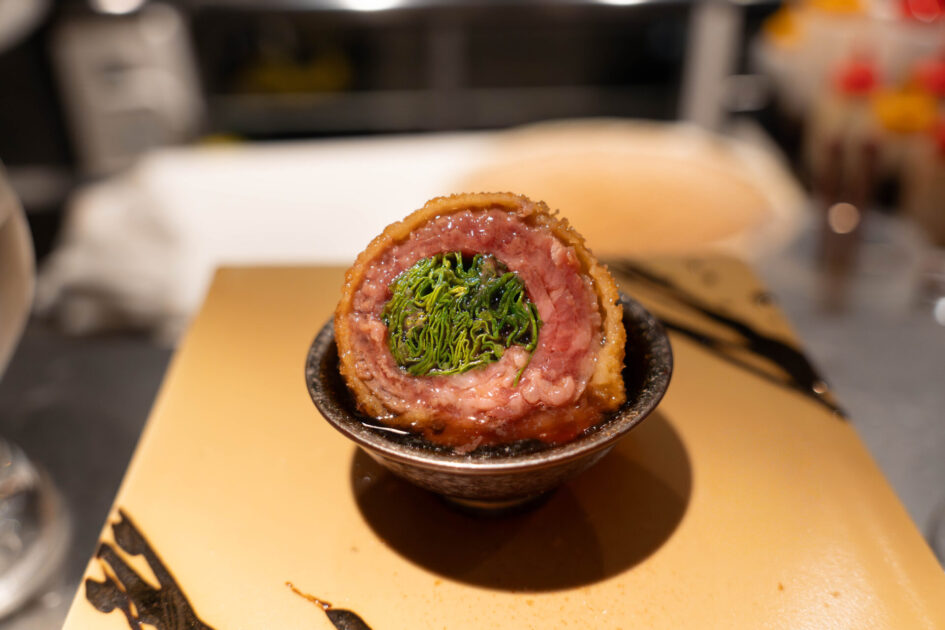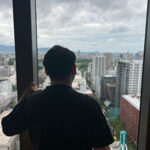CONTENTS
About Kushiage Hayashi
Concept
“Kushiage Hayashi” first made its name in Tokyo’s Kagurazaka as a hidden gem — a reservation-only restaurant beloved by insiders. After earning its reputation as one of the city’s most sought-after spots, the chef returned to his hometown of Fukuoka and reopened the restaurant in April 2025.
The restaurant offers only one course — the omakase menu (¥8,800 before tax / ¥9,680 after tax) — featuring skewers of fresh, seasonal ingredients and Kyushu Wagyu beef. With just eight counter seats, guests can enjoy the intimate, live experience of watching each skewer prepared right before them.
Every detail of the frying process is carefully considered. The chef uses 100% sunflower oil for a light, clean finish, and the house-made batter has a unique viscosity that coats each ingredient gently. Even the breadcrumbs are custom-made, applied in a way that wraps the skewer from the corners rather than pressing it down — a subtle touch that shows the chef’s precision and respect for texture.
Five types of sauces are offered, and the chef personally guides each guest on which one to use for every skewer and when to eat it. Rather than simply serving food, the experience unfolds like a performance — interactive, refined, and deeply enjoyable.
Chef Hayashi: The Self-Taught Artisan Who Returned to Hakata
Born in Fukuoka, Chef Hayashi spent 17 years training in Tokyo’s culinary scene. Inspired by a single unforgettable bite of kushiage, he began studying the craft on his own, and in November 2009, he opened “Kushiage Hayashi” in Kagurazaka with no formal background in frying. His self-taught techniques quickly earned him acclaim, and the restaurant became one of the hardest reservations in the city.
After a brief hiatus due to health reasons, Hayashi made a long-awaited comeback in his hometown of Fukuoka — a return many described as a “miracle” or “destiny.”
At the counter overlooking the Nakasu night view, Hayashi’s warm personality fills the room with ease. Many loyal customers from Tokyo still travel to dine here, drawn not only by his skill but by his humanity. His one-of-a-kind kushiage — impossible to replicate — reflects years of accumulated experience and intuition.
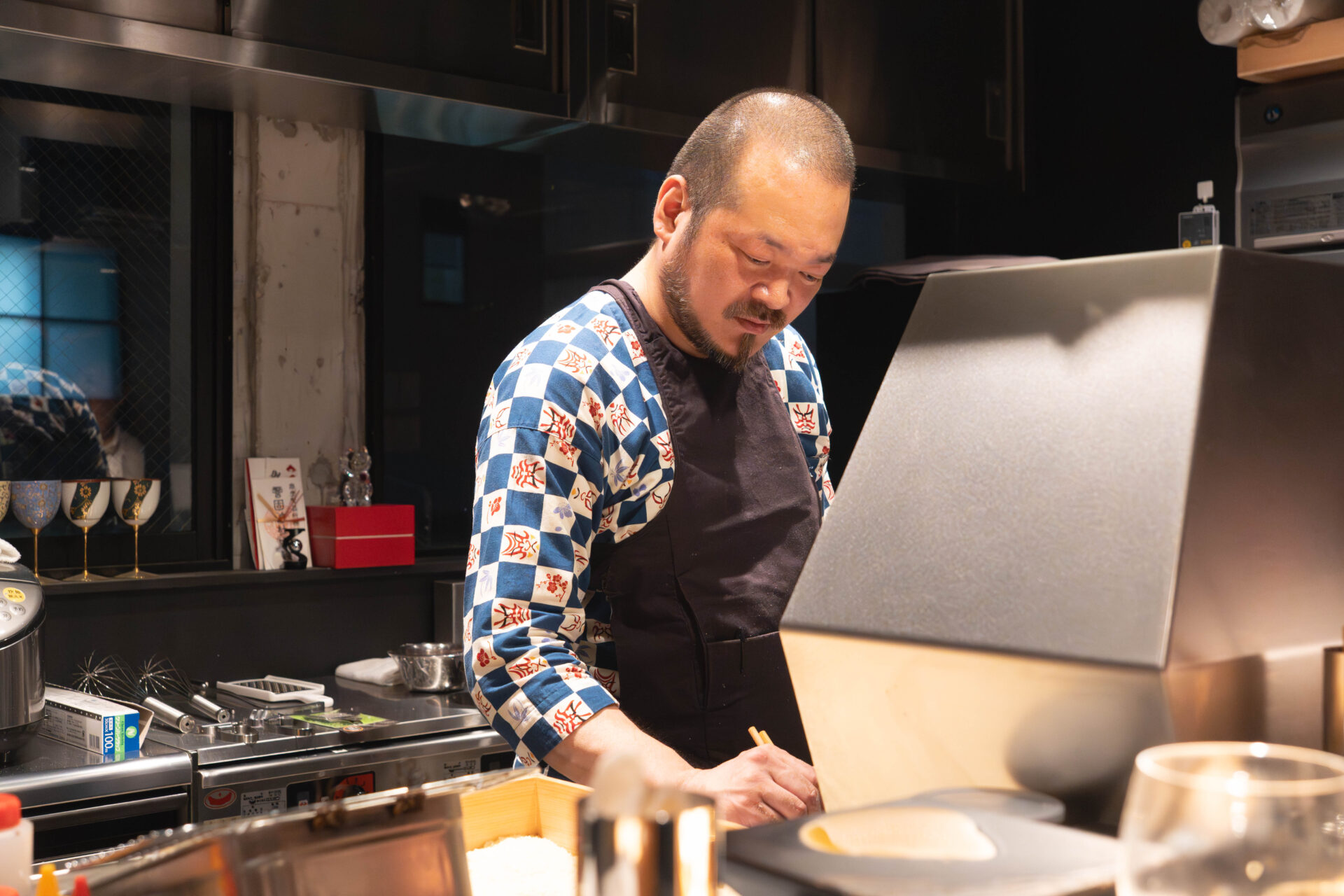
Restaurant Reputation
From its days in Kagurazaka to its new home in Fukuoka’s Sumiyoshi district, “Kushiage Hayashi” has always been more than just a skewer restaurant — it’s a stage for craftsmanship and dedication. Having earned consecutive Tabelog Awards, the restaurant’s precise control of heat and Hayashi’s intuitive frying — honed entirely through self-study — have left a strong impression on all who visit.
Even after relocating, its character remains unchanged: the light, crisp batter, the natural flavor of each ingredient, thoughtful palate cleansers, and refined pairings with sake all contribute to a deeply memorable experience.

Dining Prelude
Exterior & Entrance
Tucked away on the 7th floor of the “modern bureau sumiyoshi riva” building in a quiet corner of Sumiyoshi, Kushiage Hayashi feels like a secret destination known only to those invited. There’s no flashy signage — just a discreet entrance that seems to open only for those who seek it.
After ascending the stairs or elevator, you’re greeted by a simple doorway. As you slide it open, the lights of Nakasu twinkle beyond the counter, and you instinctively slow your breath. It’s an entrance designed to shift your senses from the outside world to something more intimate.
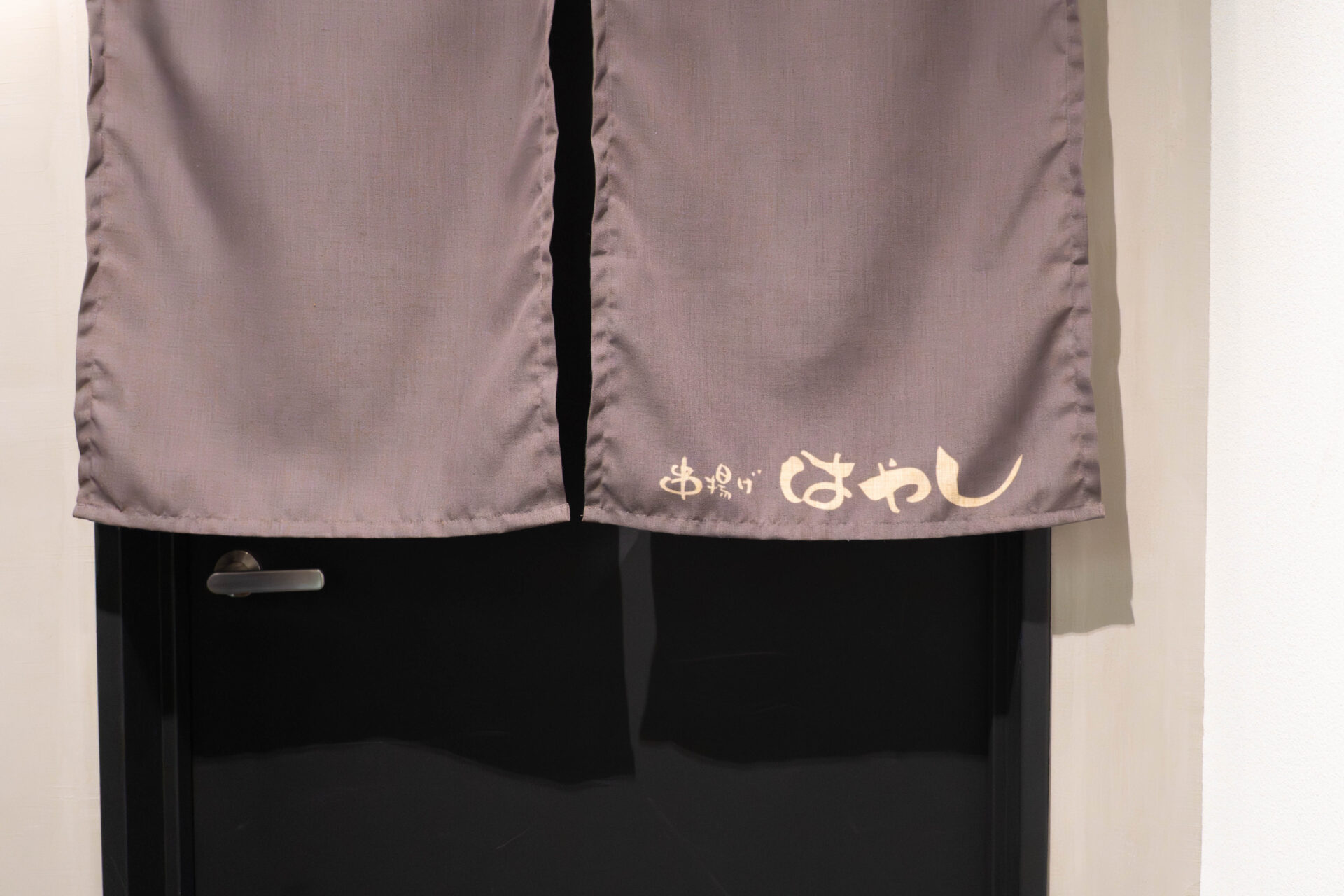
Dining Space
Behind the door lies an eight-seat counter of warm wood, its single slab stretching across the space like a stage. The aroma of freshly fried skewers fills the air as the chef works just in front of you. Every sound — the sizzle, the gentle motion of plating — creates a quiet rhythm that defines the meal.
There are no unnecessary theatrics. The beauty of the experience lies in its stillness — in how each moment feels tangible, alive, and fleeting.
Before the first skewer arrives, five dipping sauces are placed before you: dashi soy, salt, ponzu, light soy, and a sweet house sauce.
For each skewer, the chef gently advises — “This one with salt,” “That one with ponzu.” Each sauce acts not just as seasoning, but as a guide that brings out the essence of the ingredient.
The softness of dashi soy, the clean sharpness of light soy, the richness of the sweet sauce — each encounter highlights the individuality of the skewer, making the tasting progression a journey in itself.
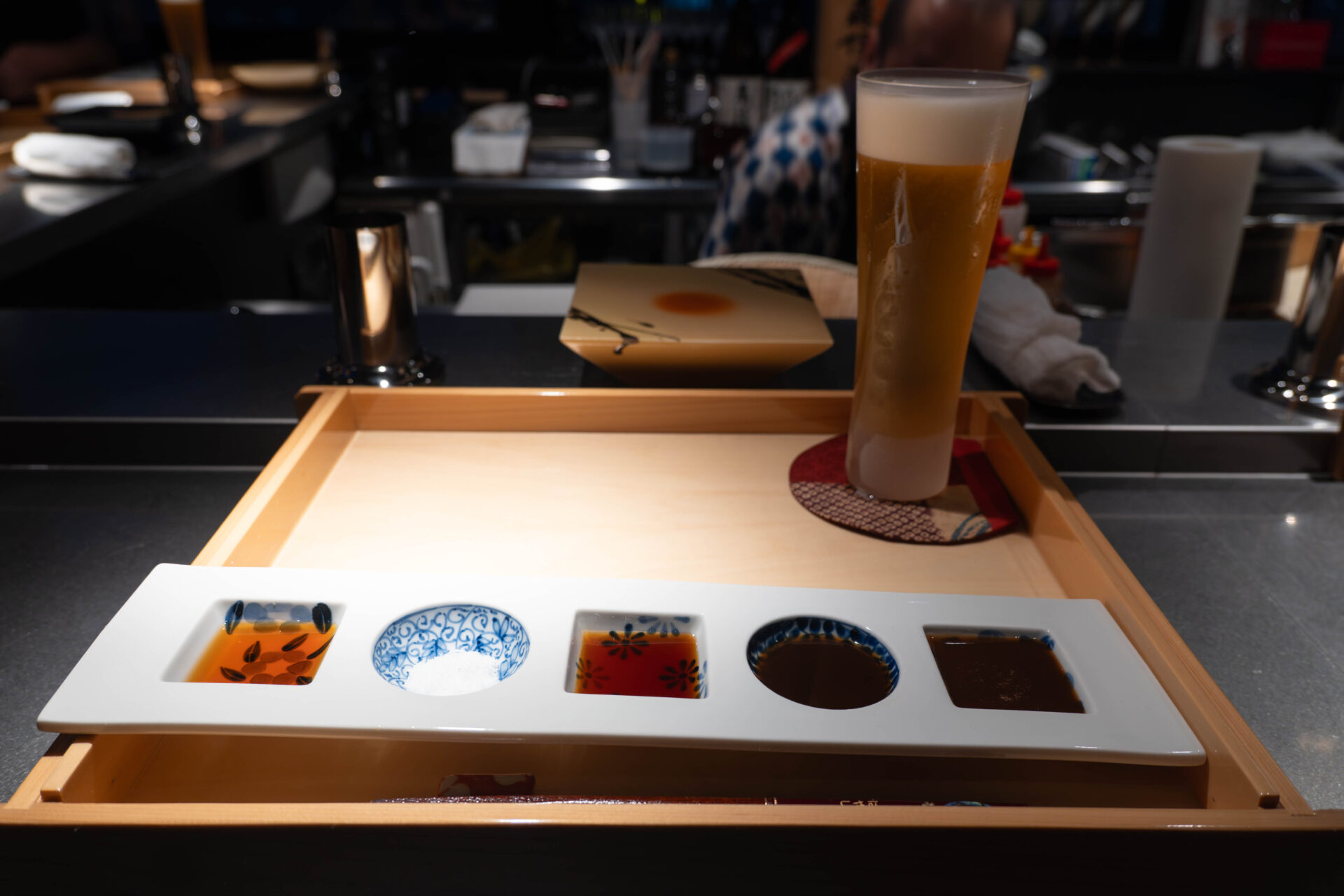
Menu Presentation
Now in Fukuoka, the restaurant offers a single omakase course only. Priced at ¥8,800 before tax (¥9,680 with tax), the menu can be enjoyed by solo diners or groups of up to eight.
The course content varies depending on the day’s ingredients and the number of guests. Usually around ten skewers, with a few palate cleansers in between — every element feels spontaneous and alive. The lightness of the coating and purity of flavors are the hallmarks of Hayashi’s craft.
The same dedication to thin, airy batter and delicate texture — unchanged since his Tokyo days — continues here, enhanced by thoughtful sake and wine pairings that complete the experience.
Dishes Experienced
Shrimp and Shiso
The first skewer served was shrimp wrapped with shiso. The moment you bite in, the shrimp’s springy texture and sweetness fill your mouth, while the refreshing aroma of shiso adds a clean finish.
Thanks to the sunflower oil, the batter is astonishingly light, allowing the natural flavor of the shrimp to shine. Simple in concept yet technically perfect — a single bite that immediately conveys the identity of “Kushiage Hayashi.”
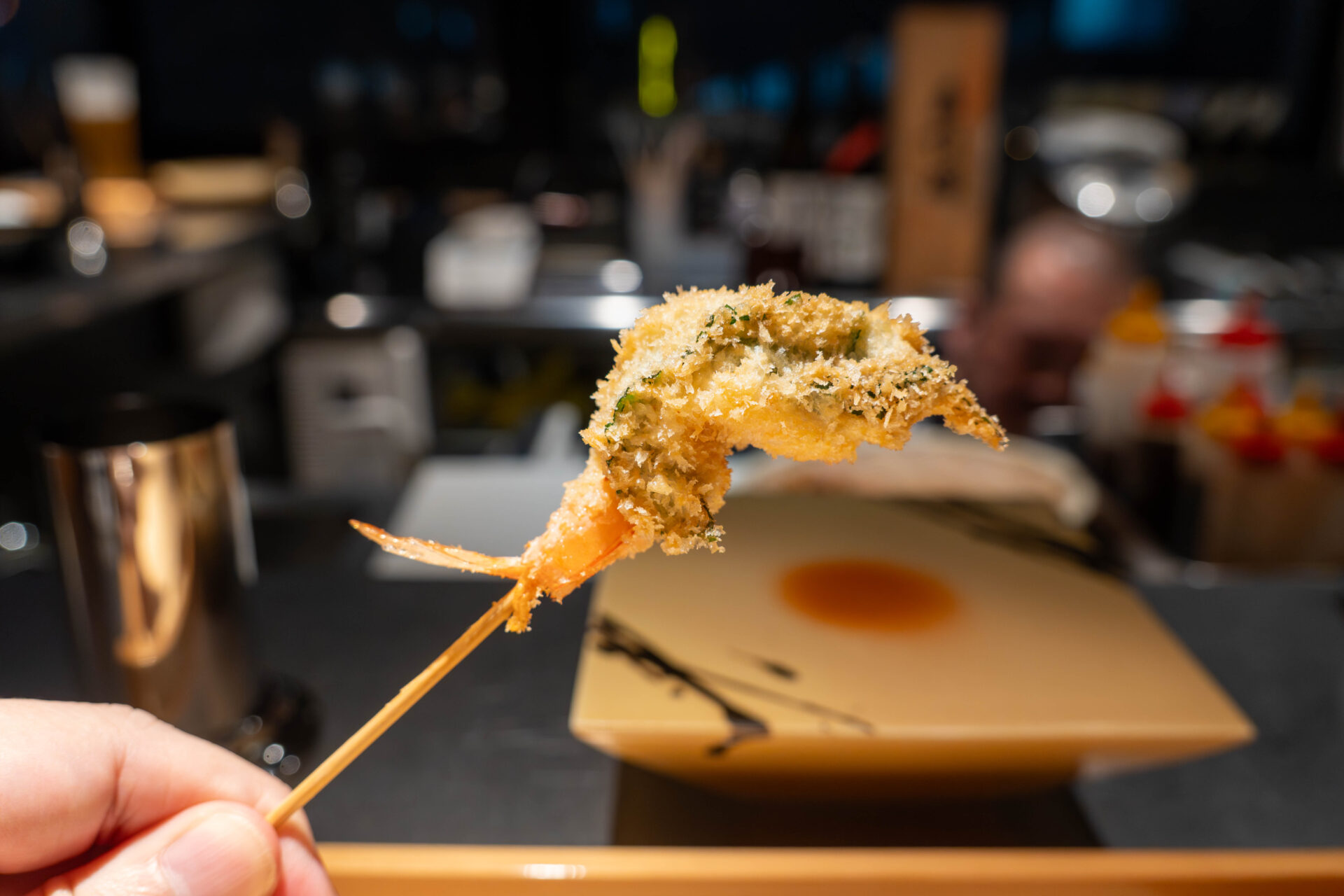
Sake Pairing
Between skewers, we were served a freshly pressed sake made with Bizen Omachi rice from Okayama. The generous pour — brimming to the rim of the glass — reflects Chef Hayashi’s hospitality and wish for guests to truly enjoy the drink.
The clean, transparent taste complements the light crispiness of the batter, enhancing the sweetness and aroma of each skewer. This seamless rhythm between food and sake creates a comfort that defines the experience here.
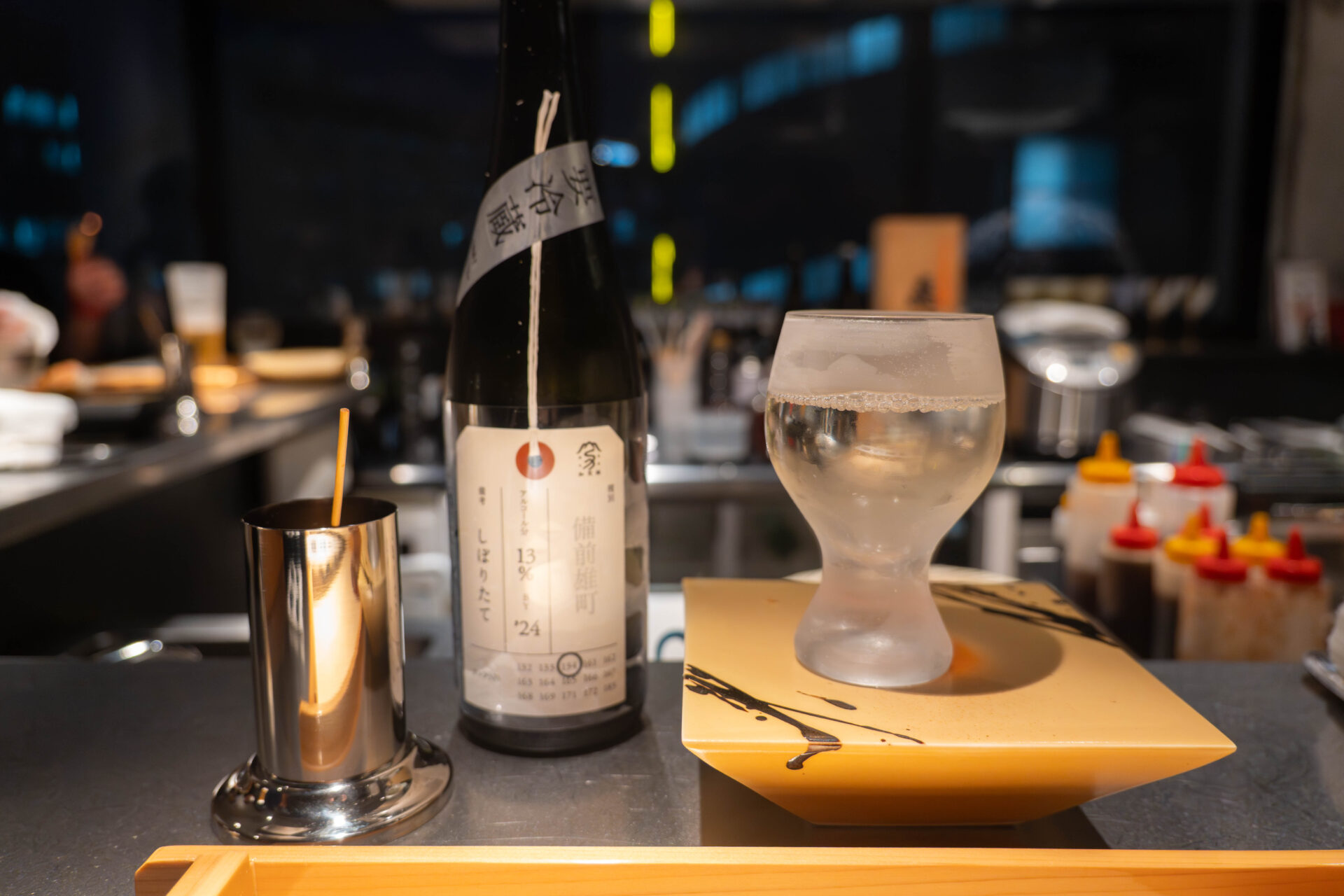
Snow Crab
Next came snow crab — the claw meat tightly packed and fried just to seal in the natural heat. Even holding the skewer is almost too hot to touch.
As you bite through, the sweetness and aroma of the crab bloom. The paper-thin coating gently encases the meat, allowing the warmth and umami to gradually unfold with each bite.
It’s a deceptively simple piece that shows the precision of his heat control — combining the richness of crab with the lightness unique to kushiage.
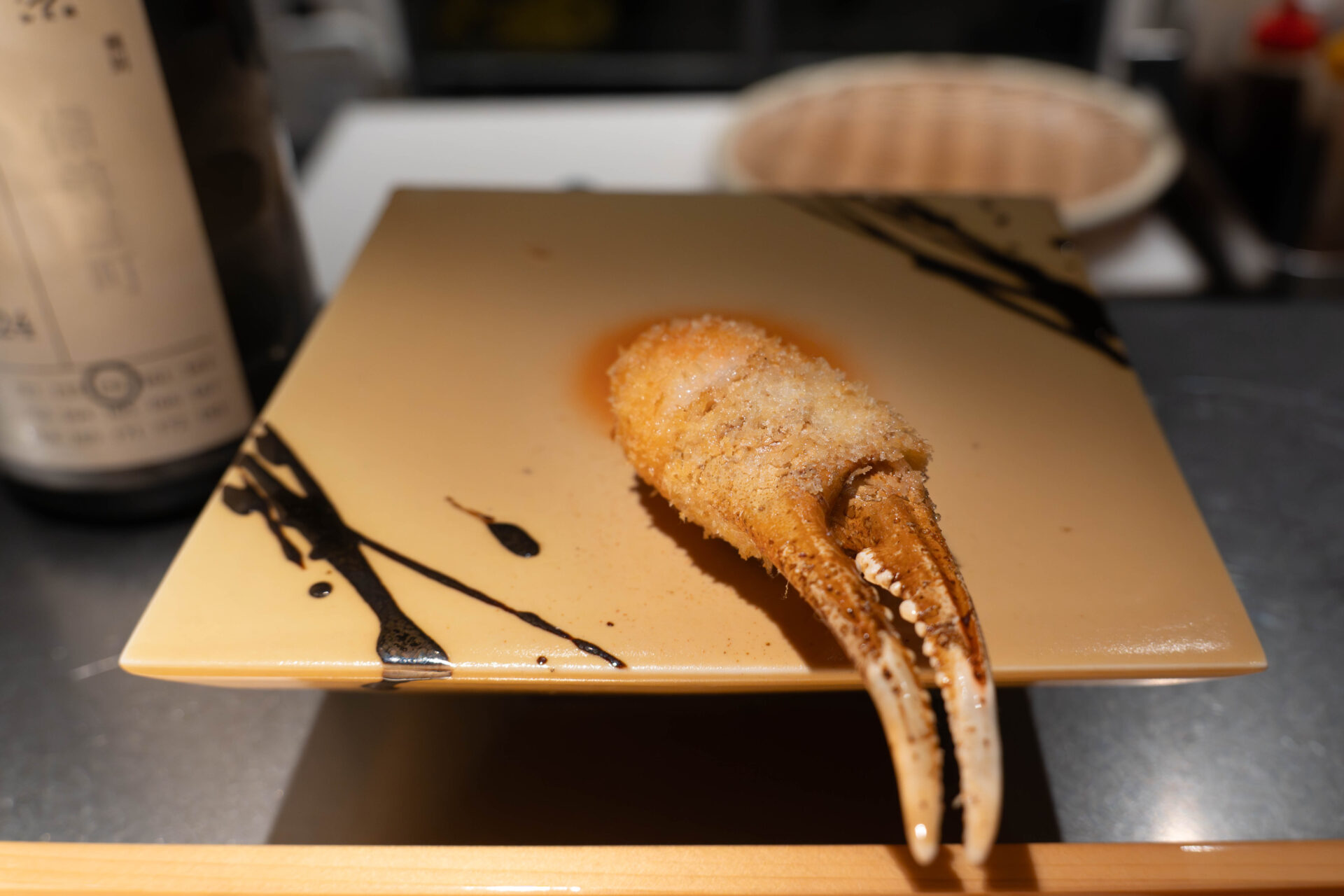
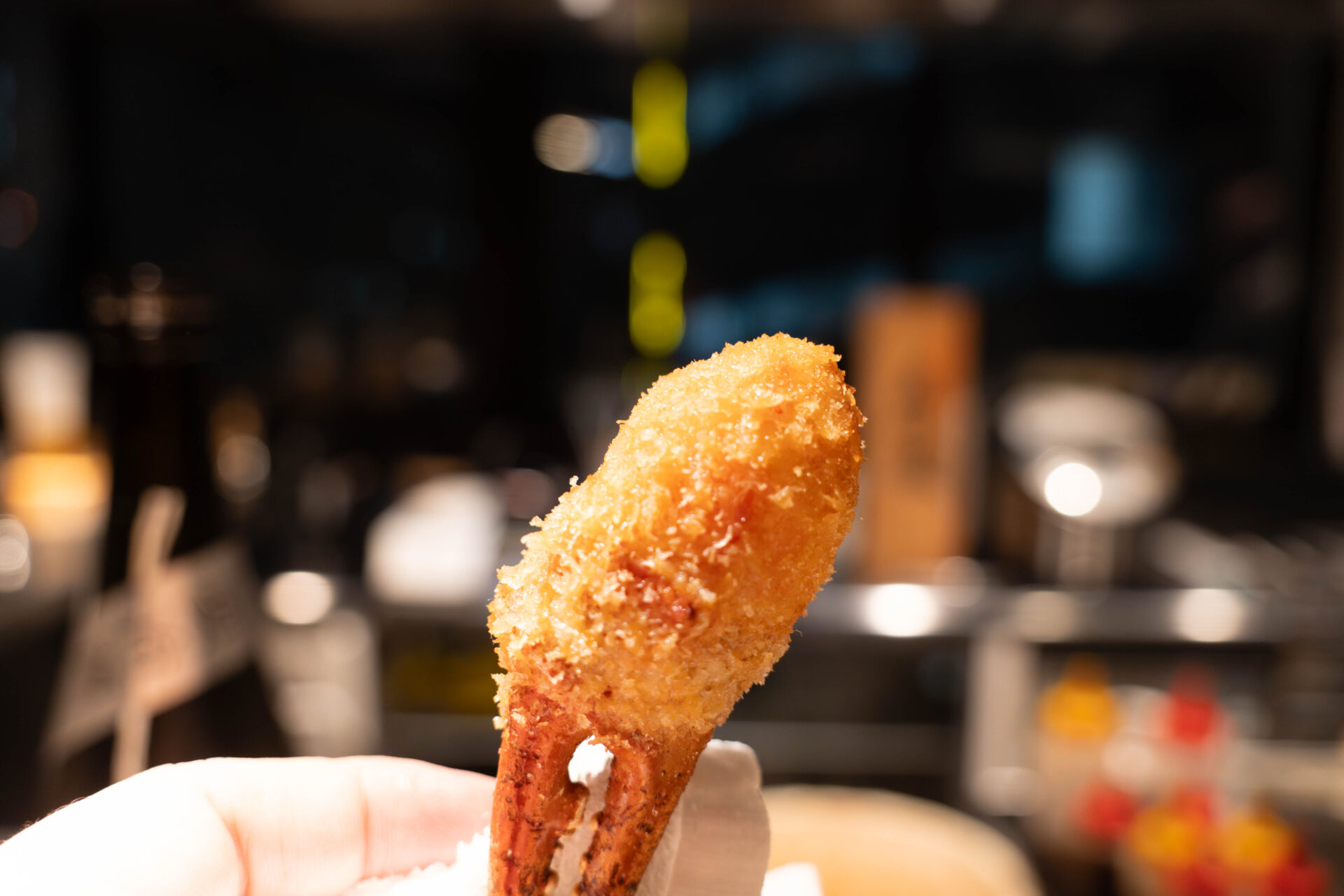
Chicken and Leek (Negima)
This skewer of chicken and Japanese leek evokes the classic “negima” of yakitori — yet expresses it through frying. The leek is skewered vertically to preserve its texture and aroma, while the chicken remains tender and juicy inside.
The crispy exterior contrasts with the moist chicken and the gentle sweetness of the leek. Through precise temperature and timing, the skewer achieves a unity of flavor and texture only possible through kushiage.
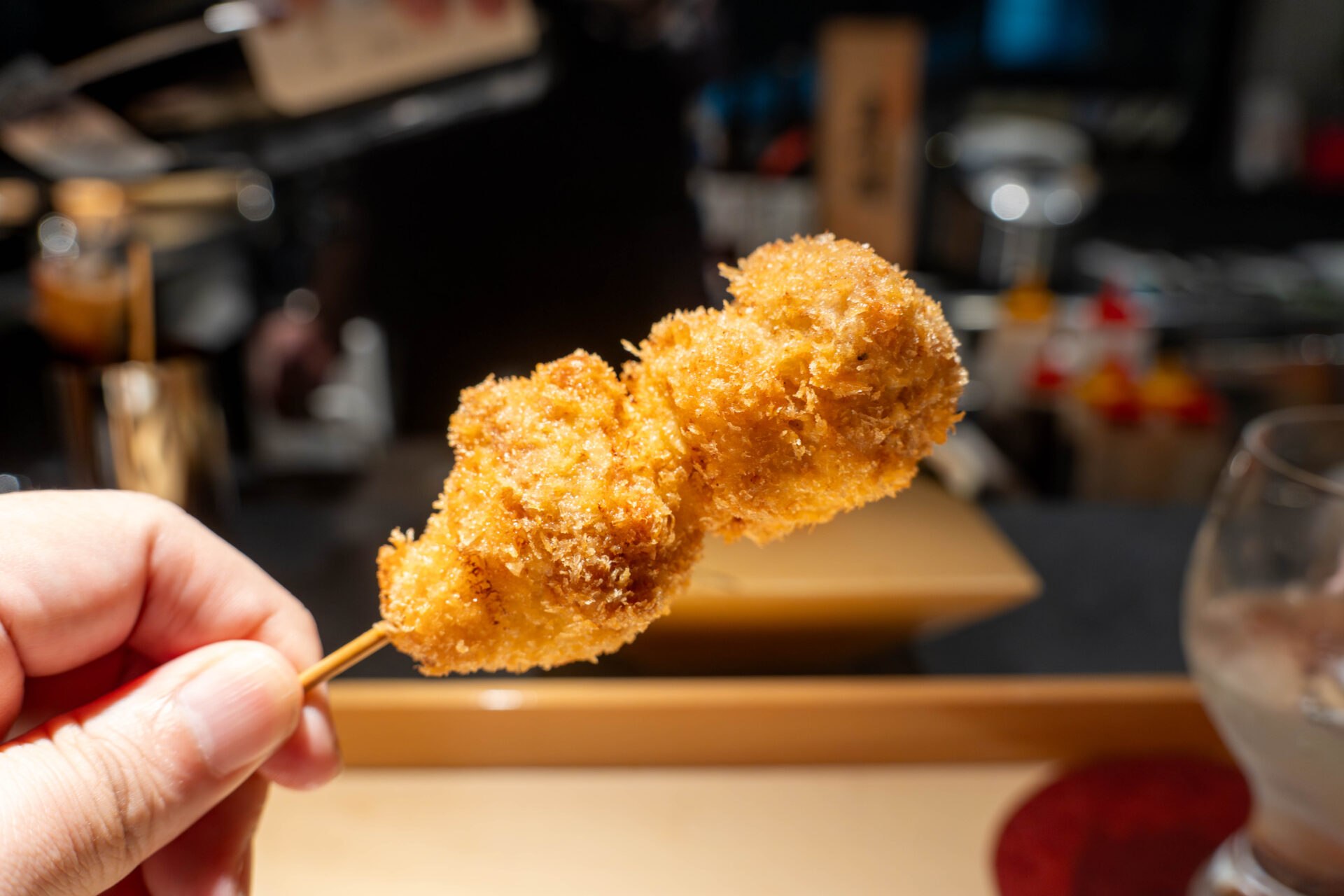
Fresh Karasumi (Bottarga)
As a palate cleanser, fresh karasumi was served. Its creamy texture and subtle salinity unfold slowly on the tongue — different from the usual dried version, with a delicate graininess that pairs beautifully with sake.
Sipping sake between small bites offers a luxurious pause — a moment of stillness that refreshes the senses before the next skewer.
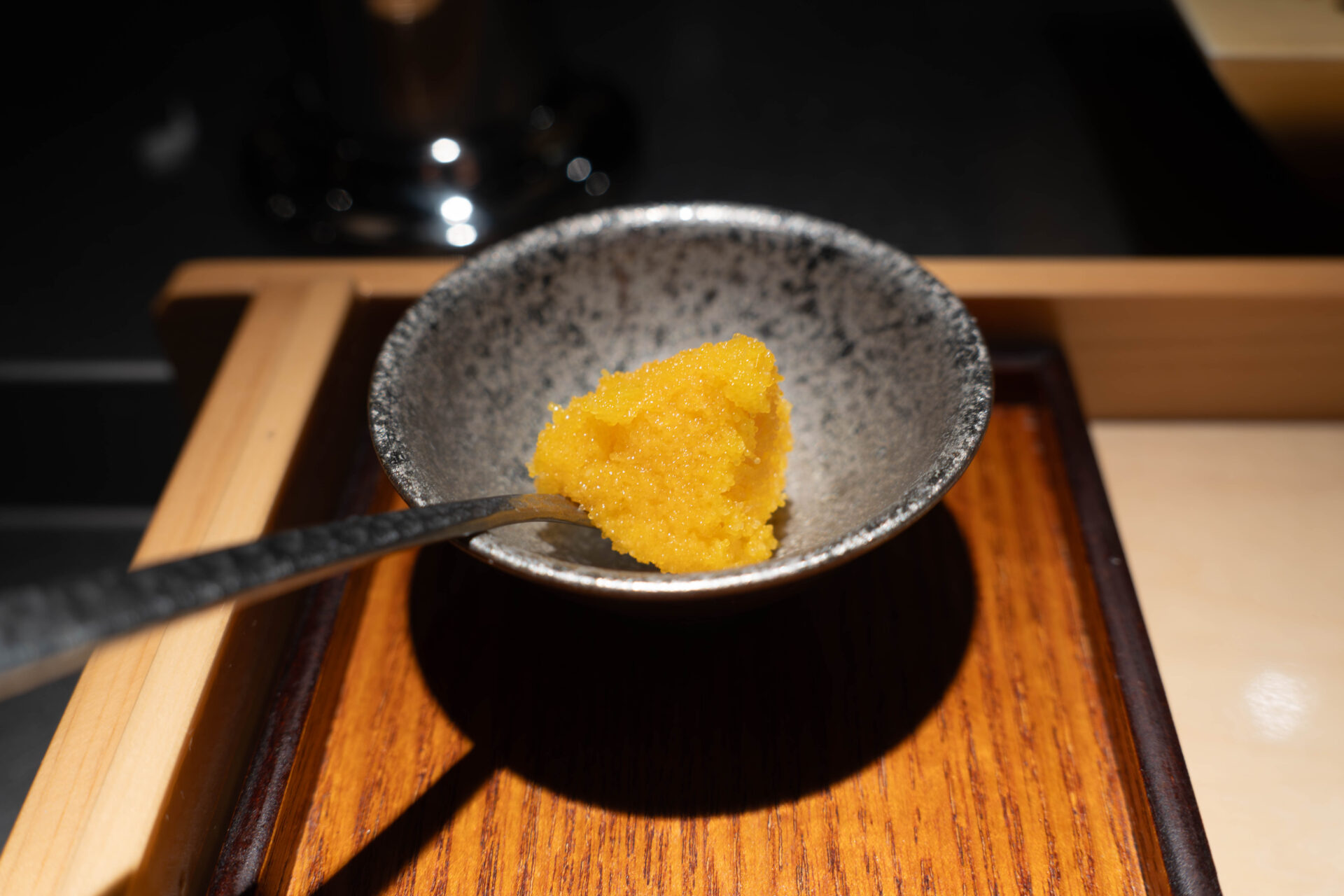
Pork Fillet
The next was pork fillet — a thick cut skewered and fried until the fine-grained meat gently puffed up. It’s tender, refined, and devoid of any heaviness.
Here, the chef suggests the sweet house sauce, one of the five condiments. The sauce’s depth of flavor enhances the natural sweetness of the pork, coating the crisp batter and leaving a warm, satisfying aftertaste.
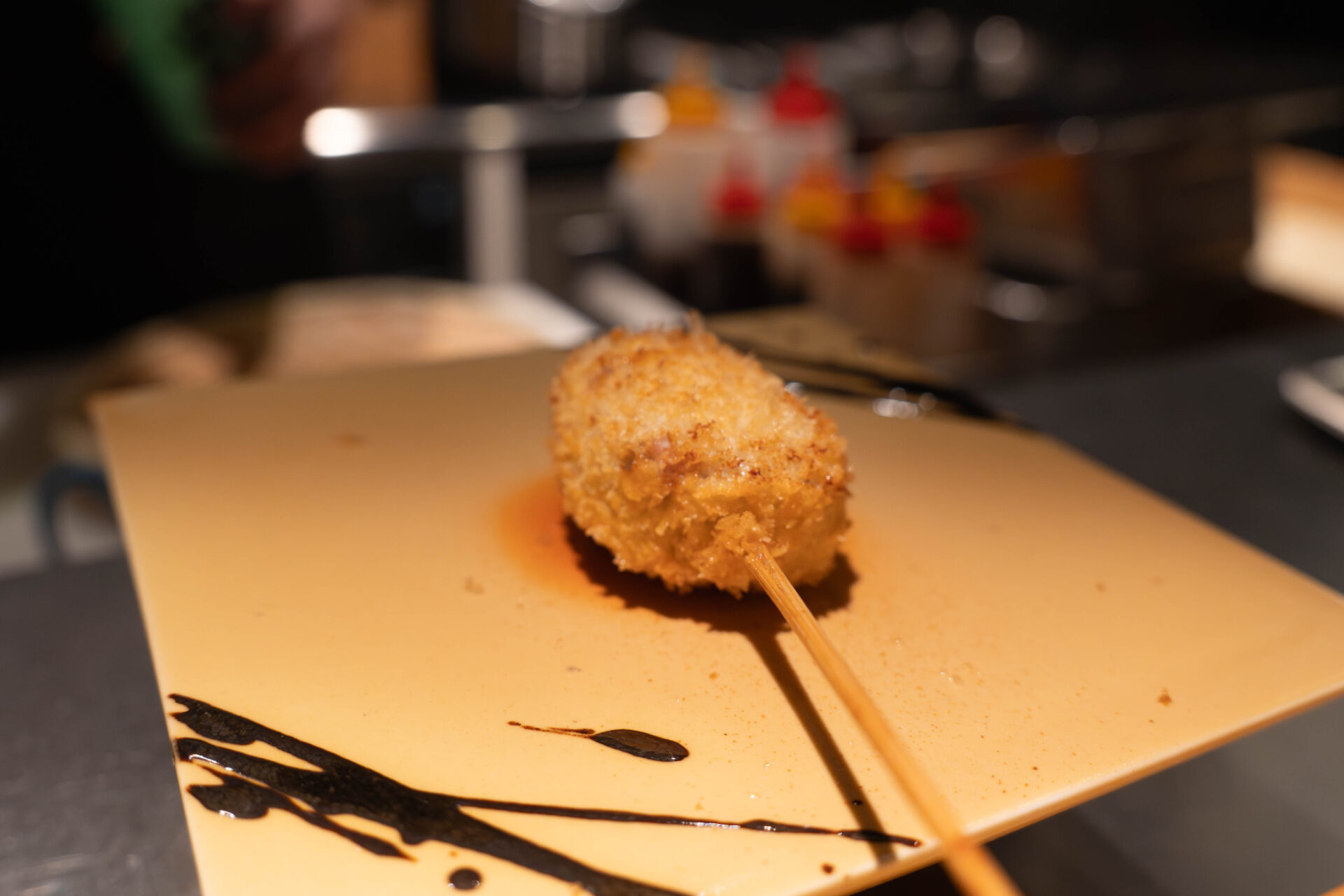
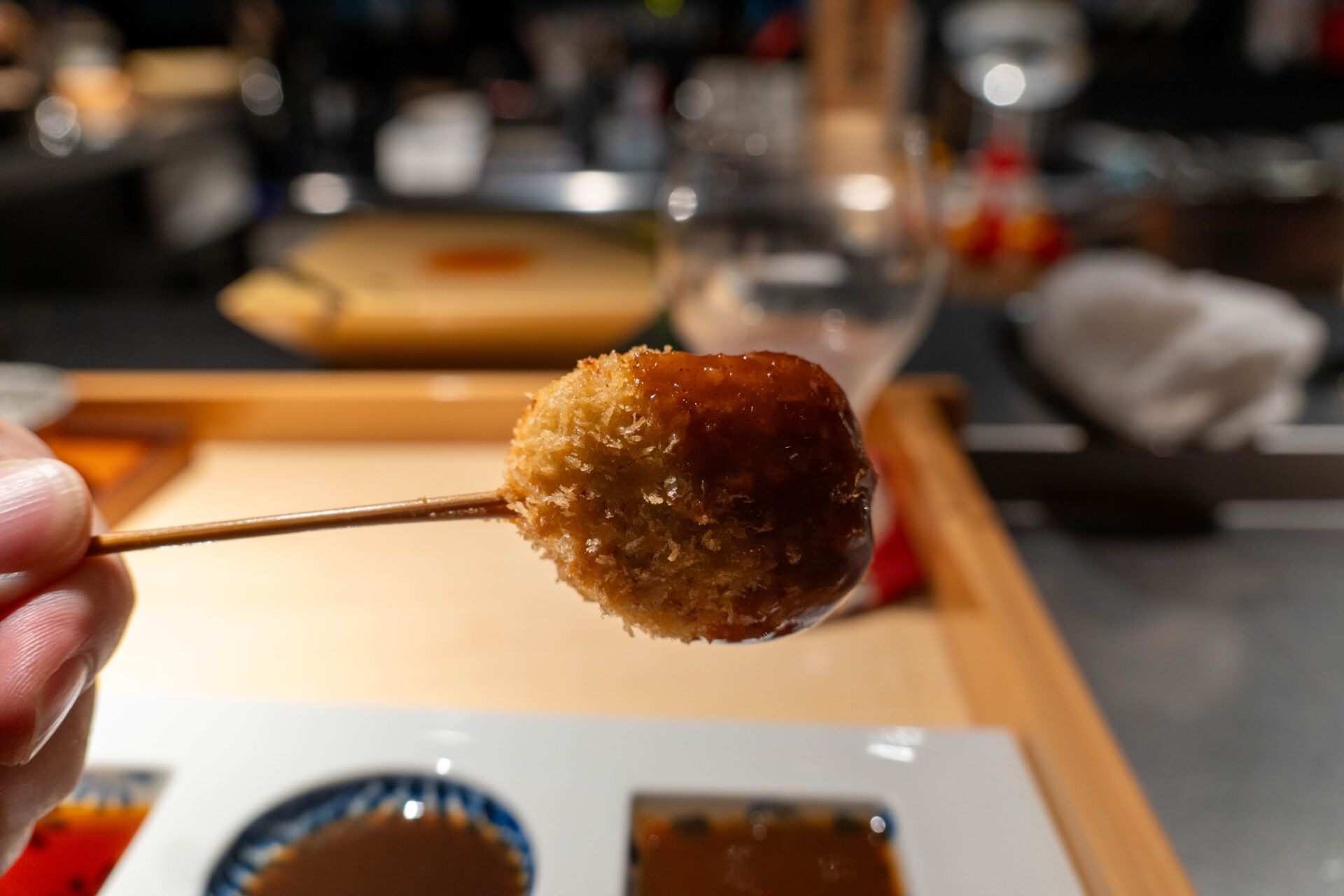
Saga Beef Tenderloin
The Saga Beef tenderloin was served straight from the oil, but Chef Hayashi gently said, “Not yet.” He lets it rest on the plate for residual heat to finish the cooking. After a moment, he nods — “Now it’s perfect.”
Cut open, the center reveals a beautiful rose hue. The meat is tender and full of umami, the batter crisp and featherlight. Despite the thickness of the cut, it feels effortless to eat.
This careful use of carryover heat elevates the dish beyond the realm of kushiage — proof of Hayashi’s deep understanding of temperature and timing.
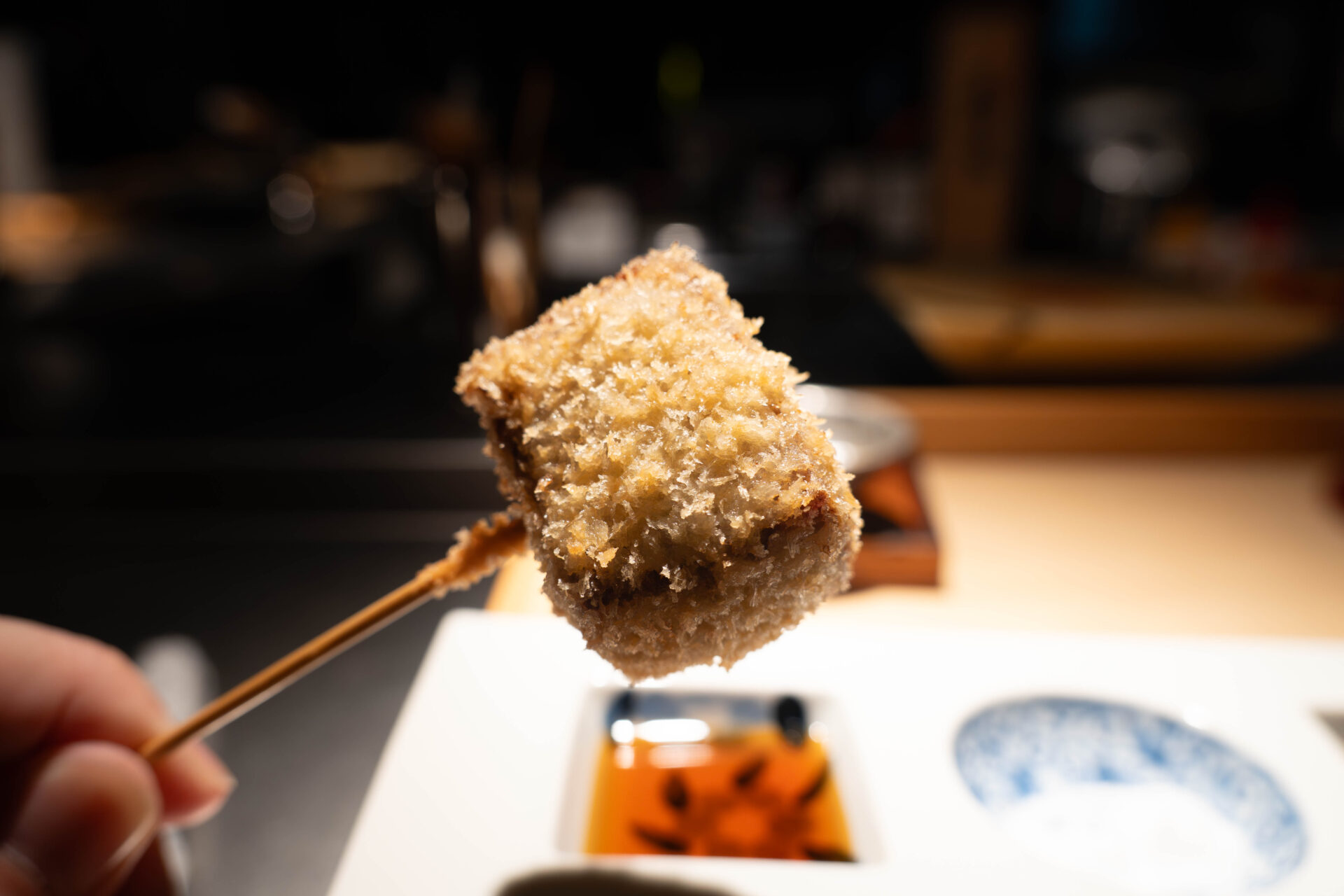
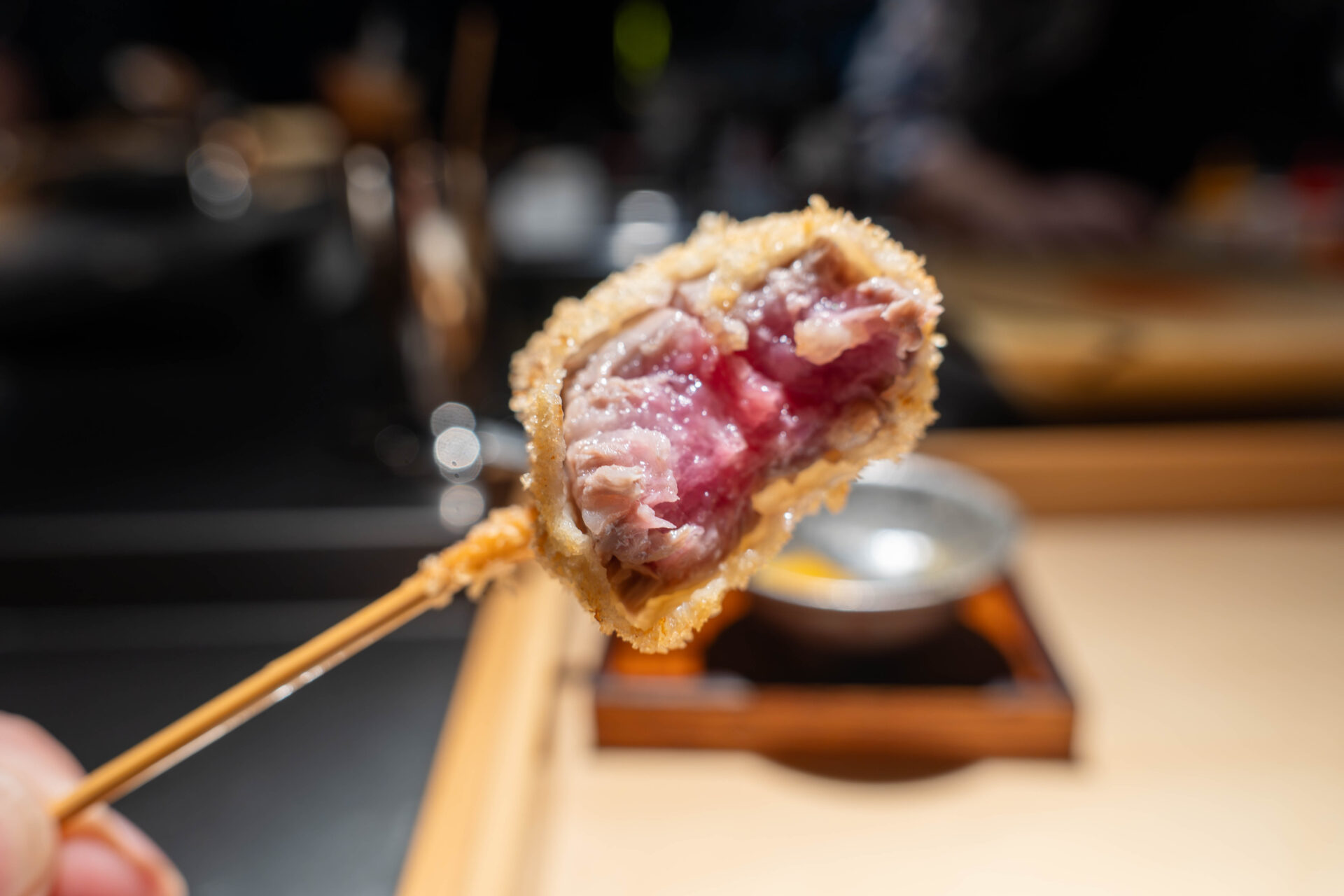
Saga Beef Sirloin
The Saga Beef sirloin is fried with a slice of garlic placed on top. When cut, the cross-section gleams with an exquisite rose tone — irresistible to look at.
Each bite reveals the savory richness of the lean meat and the sweet flavor of the fat, harmonized by the aroma of garlic that lingers softly.
The perfection of the doneness — achieved through precise residual heat — shows Hayashi’s creativity and technical control, transcending the usual image of fried food.
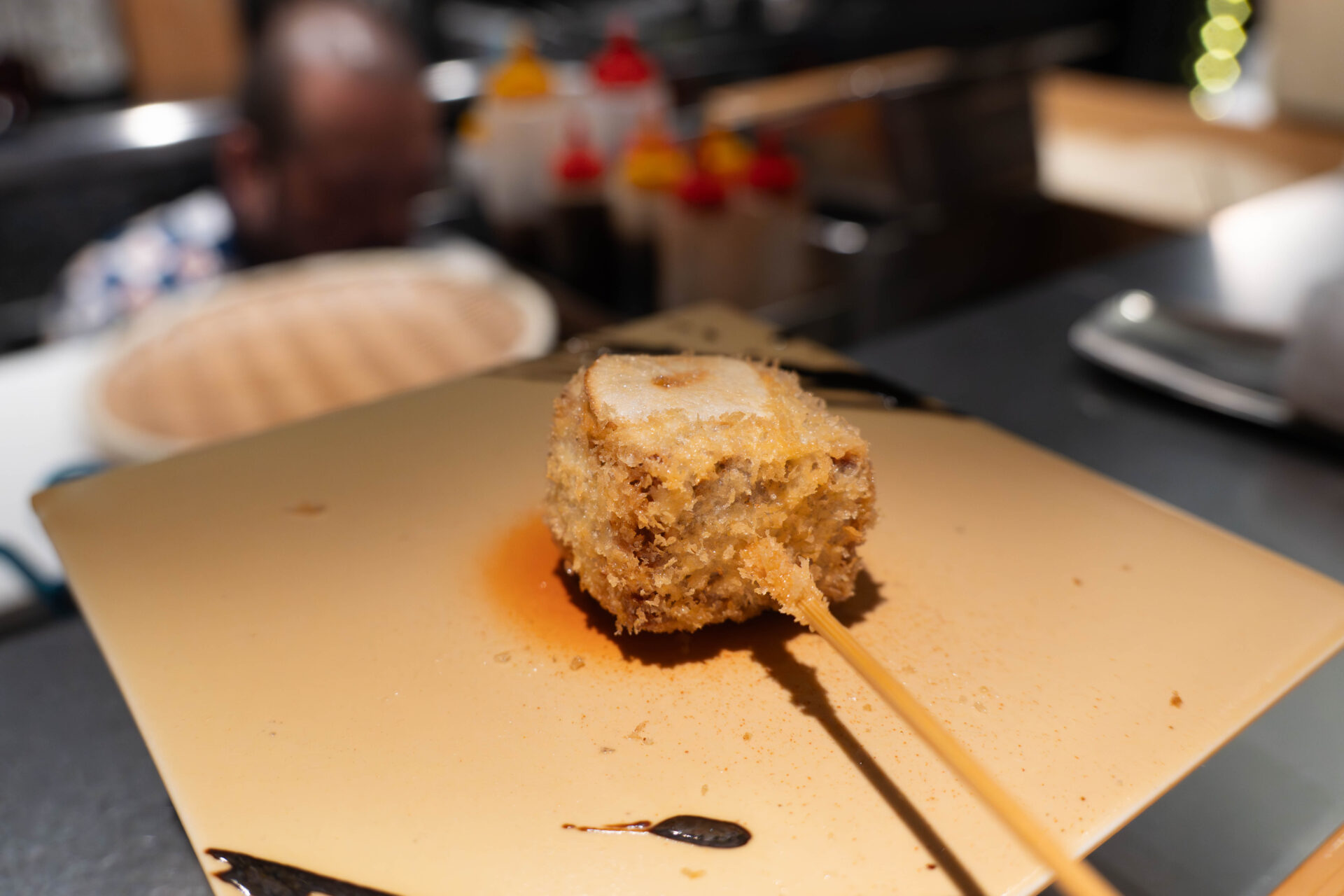
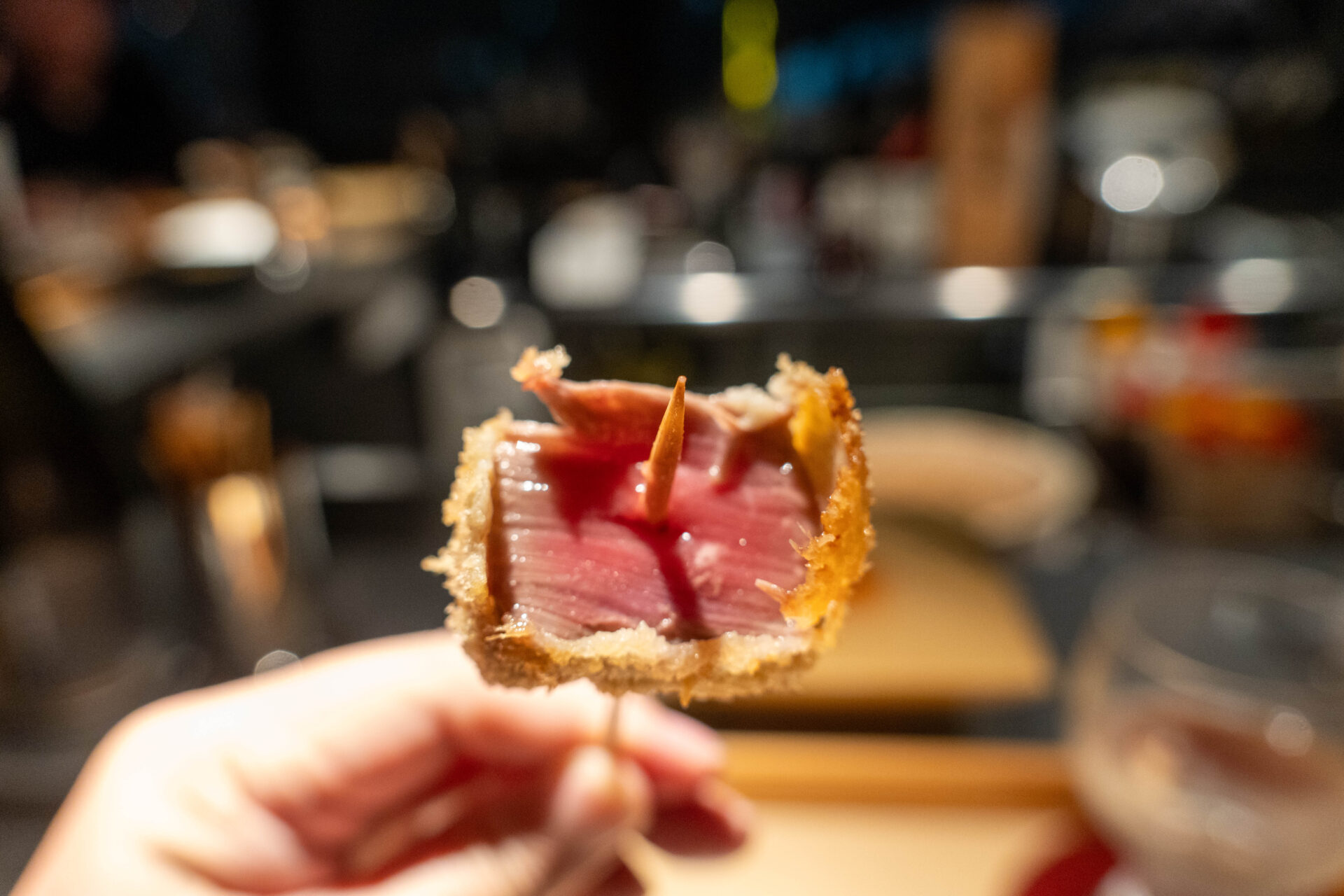
Saga Beef Sirloin Yukhoe
Between the fried courses came a chilled interlude — a glass of finely chopped Saga Beef sirloin yukhoe. The balance of lean and marbled meat glistens in the glass, exuding luxury.
Instead of egg yolk or heavy sauce, this version highlights the natural sweetness and texture of the beef itself. The cool temperature and clean flavor provide a refreshing contrast to the warmth of the fried skewers.
Alternating between the yukhoe and hot kushiage amplifies both — a striking example of balance and rhythm in the course.
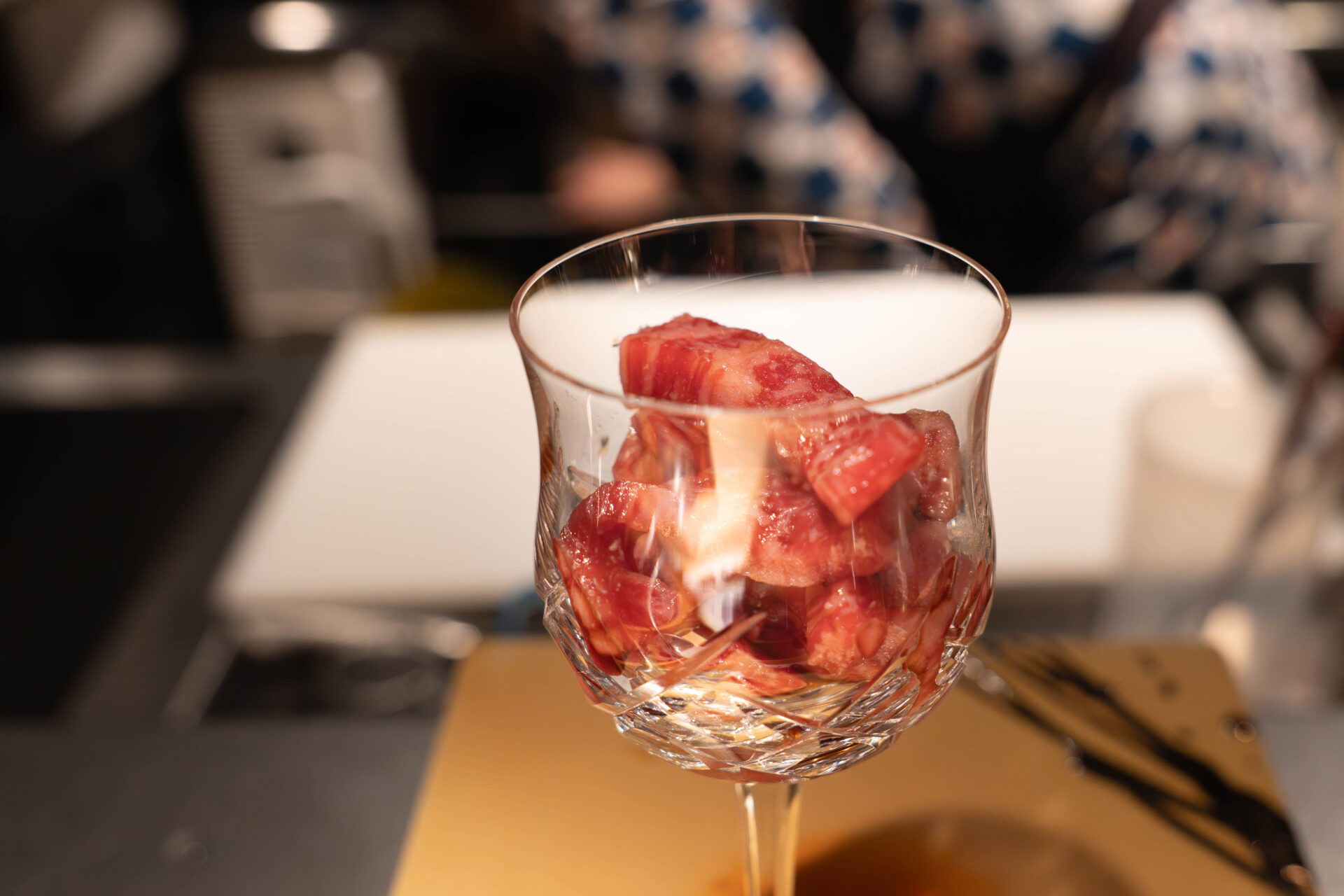
Shungiku and Sirloin (Specialty)
This signature dish features chrysanthemum greens wrapped in Saga Beef sirloin, lightly coated in batter, and fried — served in a small bowl rather than on a skewer.
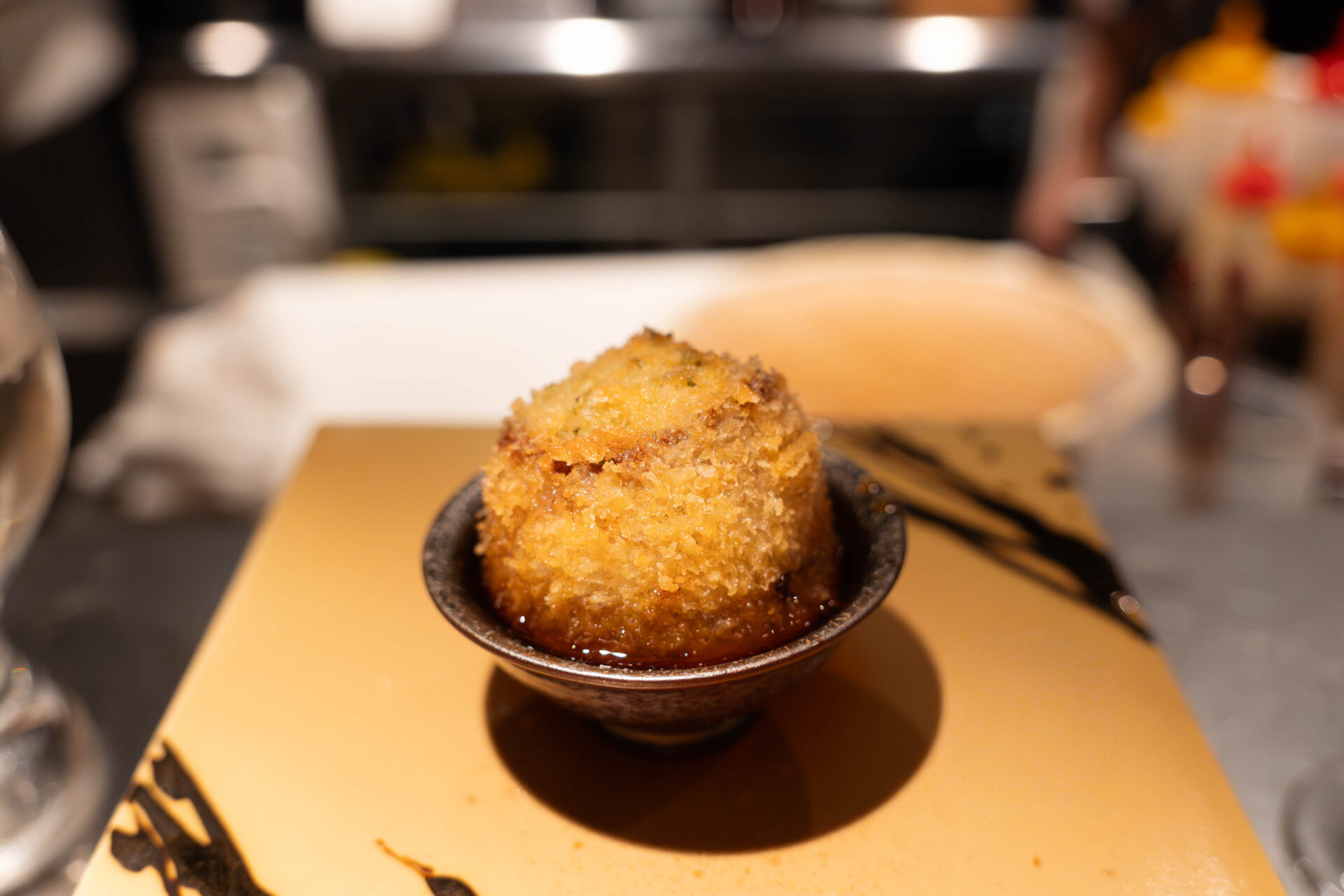
The vivid contrast of pink meat and deep green shungiku is beautiful. Each bite blends the sirloin’s sweetness with the gentle bitterness of the greens, unified by the airy coating. It perfectly embodies Hayashi’s artistry and sensitivity to flavor balance.
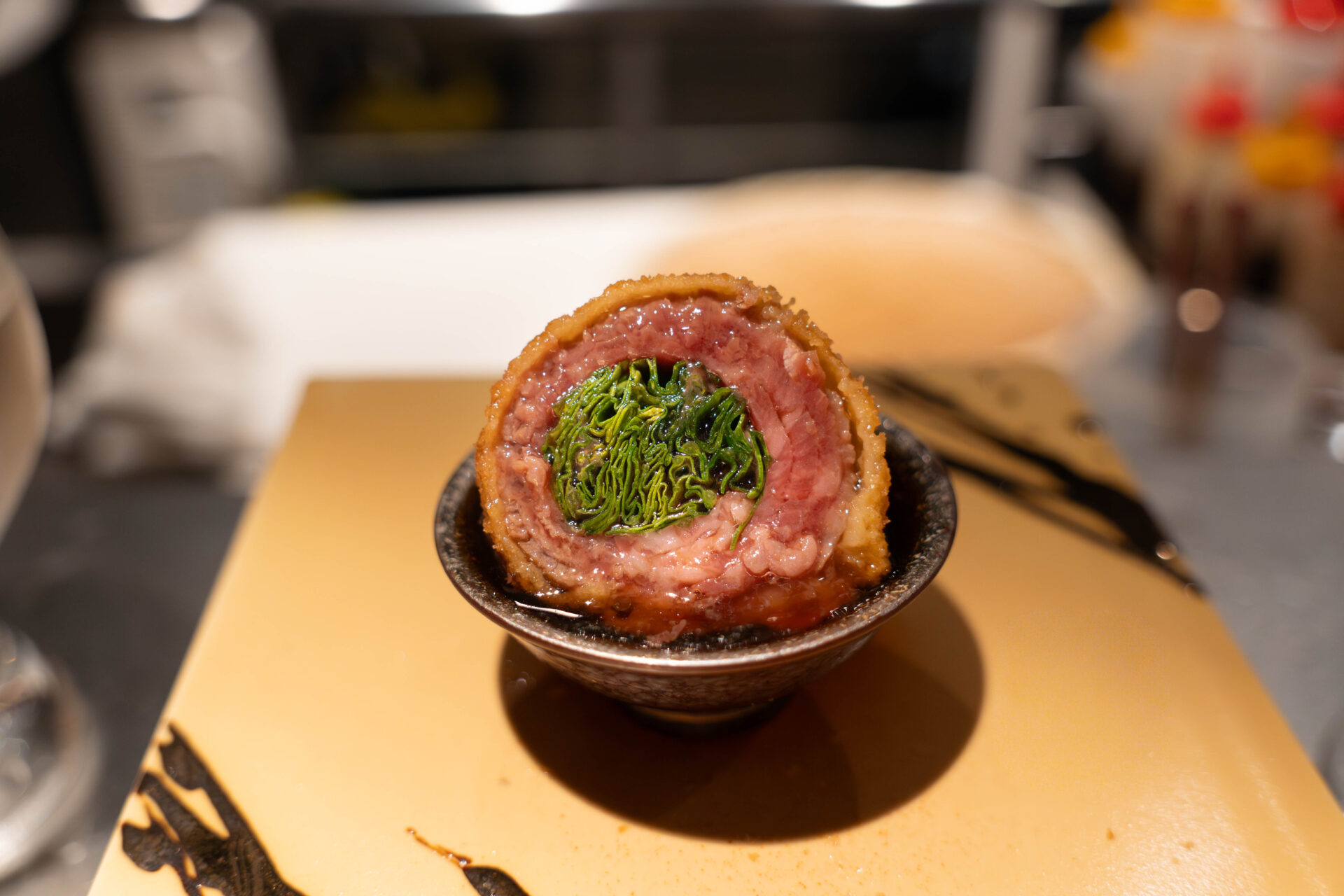
Local Chicken Tataki
The local chicken tataki is lightly seared, preserving its supple texture. Served in a glass, the presentation is striking. The first bite brings out a pleasant firmness and a slow bloom of savory flavor.
Paired with ponzu, its acidity accentuates the sweetness of the meat and refreshes the palate — an ideal reset between richer skewers.
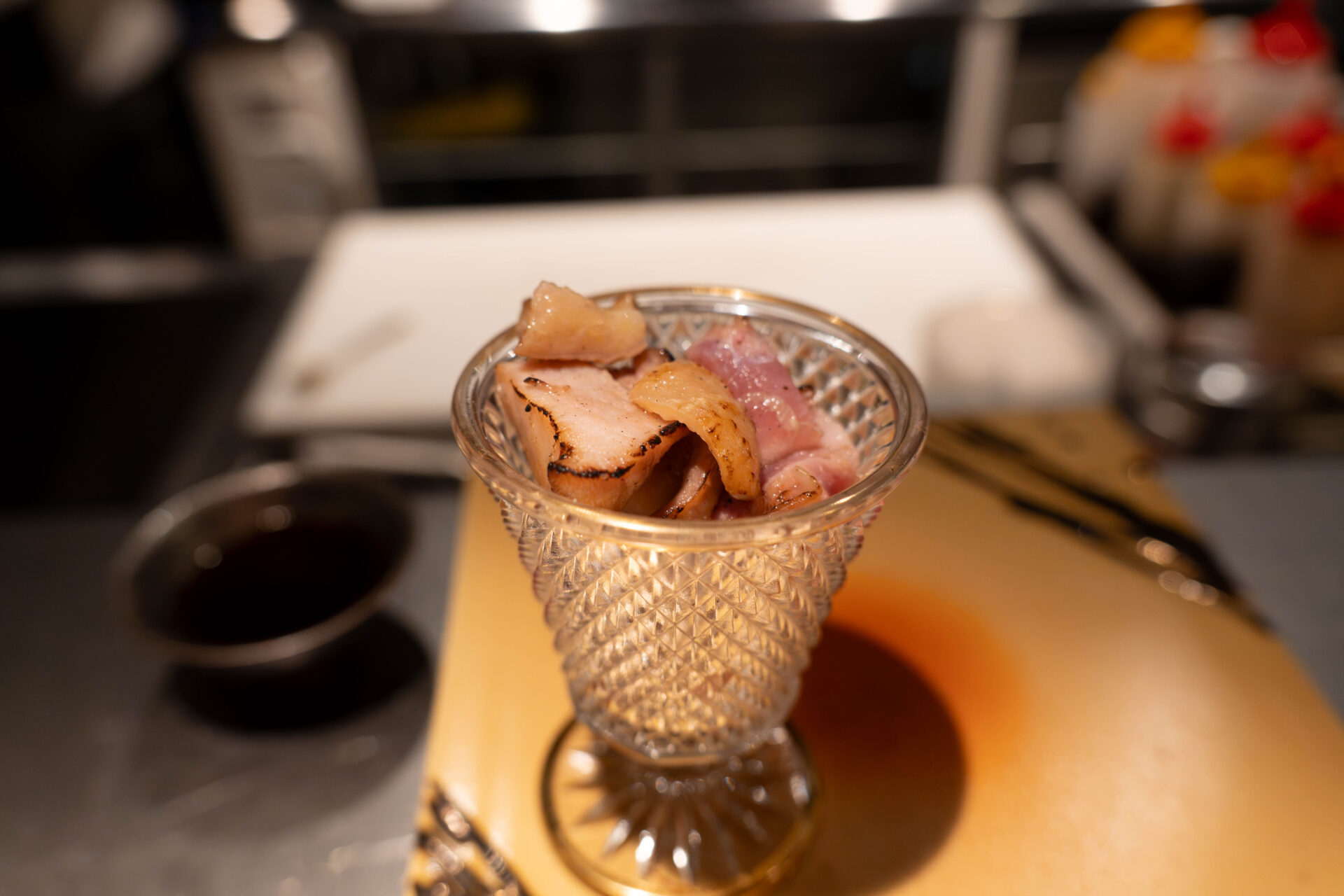
Kisu (Japanese Whiting) with Shiso
The next skewer, kisu wrapped in shiso, is elegant — the tail left intact for a graceful touch. The fluffy white fish and the fragrance of shiso rise together as you bite in.
First, enjoy it with salt: the gentle sweetness of the fish and the herbal freshness of shiso shine. Then try it with ponzu, which adds a citrusy sharpness and contrast.
A single piece that offers two distinct expressions — simple yet deeply memorable.
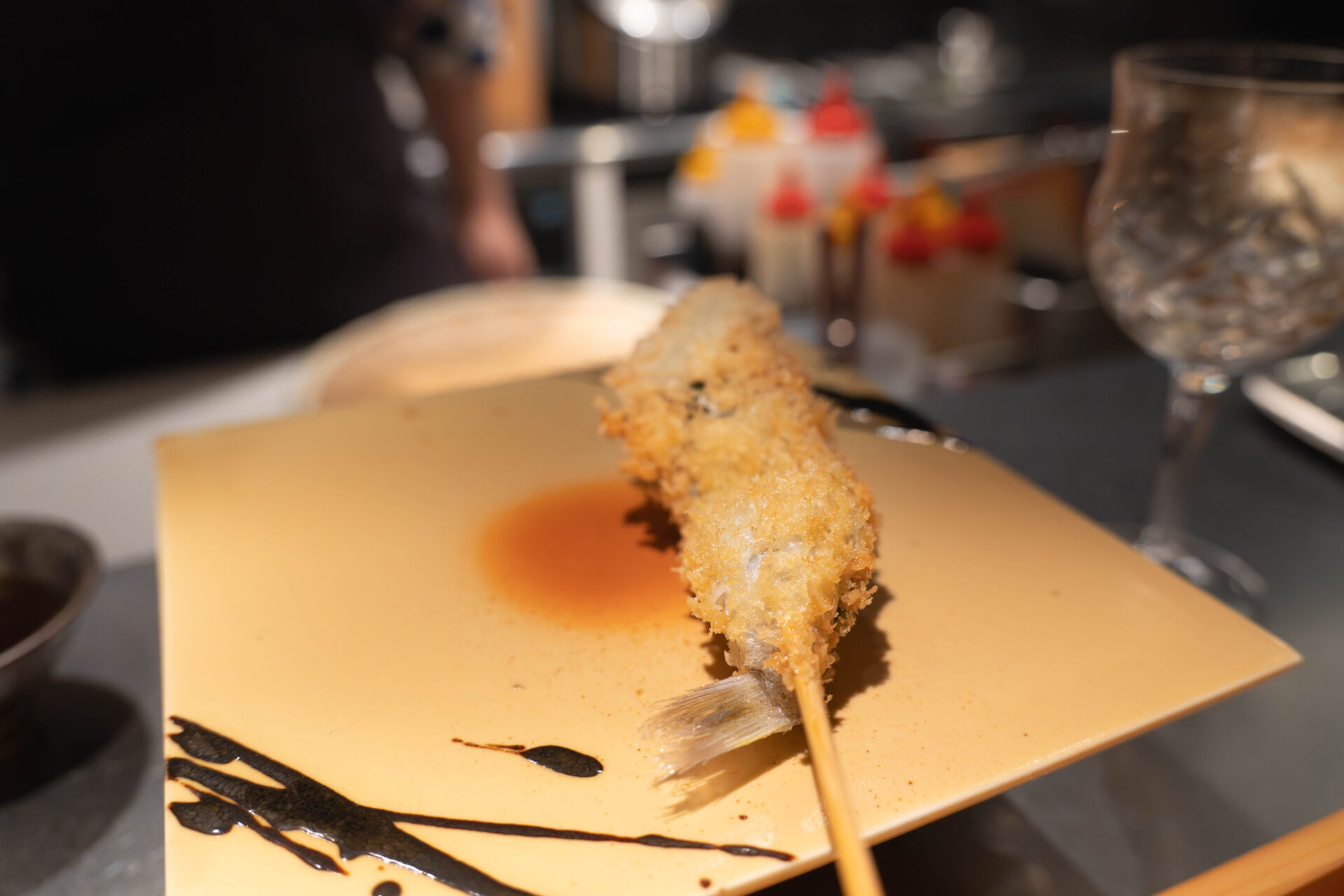
Scallop with Caviar
The final course was scallop, lightly fried and topped with a spoonful of caviar. The plump, juicy flesh and the crisp coating create a luxurious contrast.
The sweetness of the scallop expands gently, sharpened by the briny pop of the caviar — a graceful and satisfying finale.
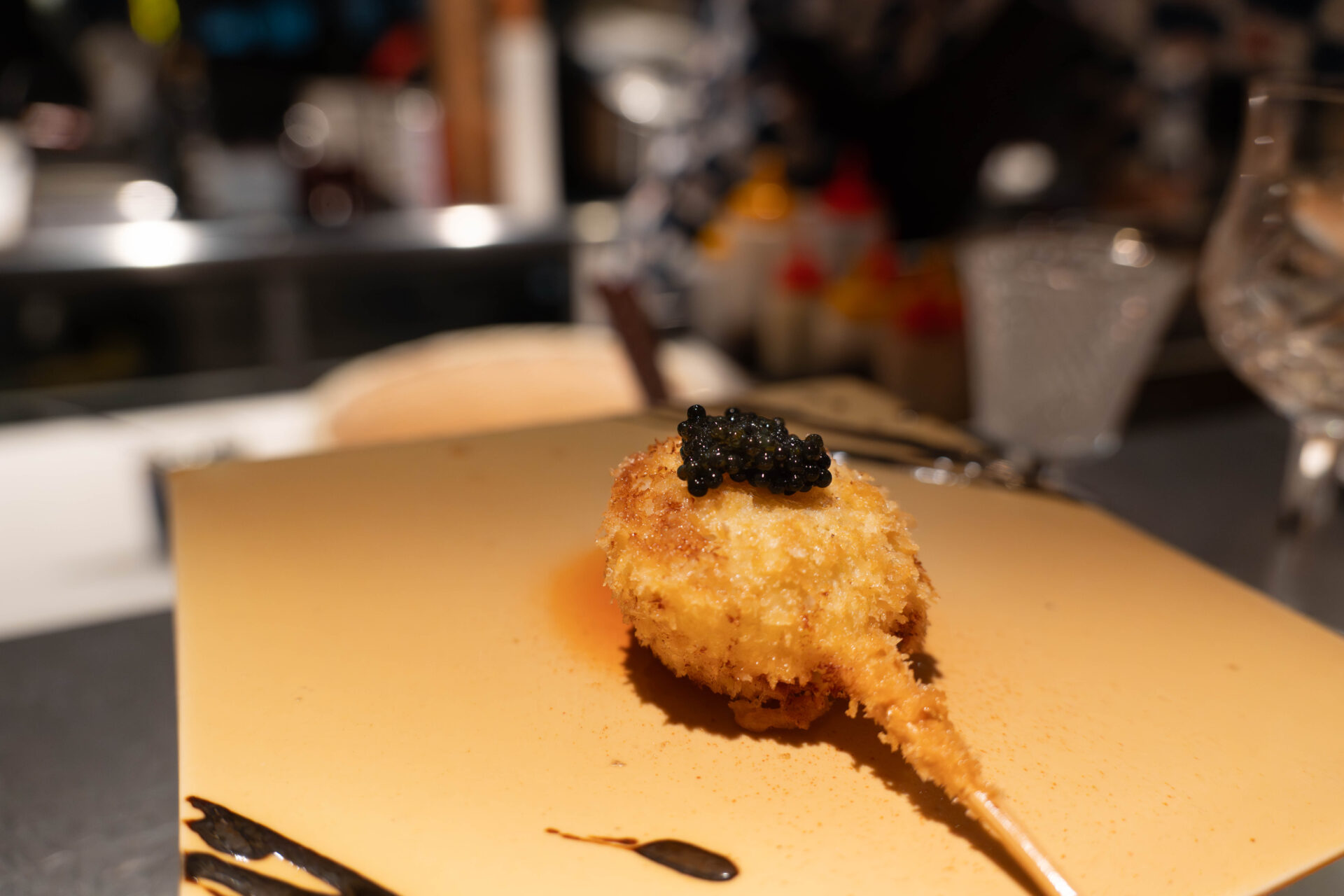
Sake and the Chef’s Spirit
The sake list is as thoughtful as the food — including Houken, Miinotsukasa “14,” Tatenokawa, and Takara. Each pairing deepens the experience and complements the warmth of the fried skewers.
What leaves the strongest impression, however, is Hayashi’s generosity: pouring sake to the brim, smiling as he serves each glass. Guests often find themselves drinking more than they planned — a joyful consequence of his infectious hospitality.
The warmth of the food and the freshness of the sake intertwine, creating a dining experience that goes beyond flavor — a moment of connection between people, place, and craft.
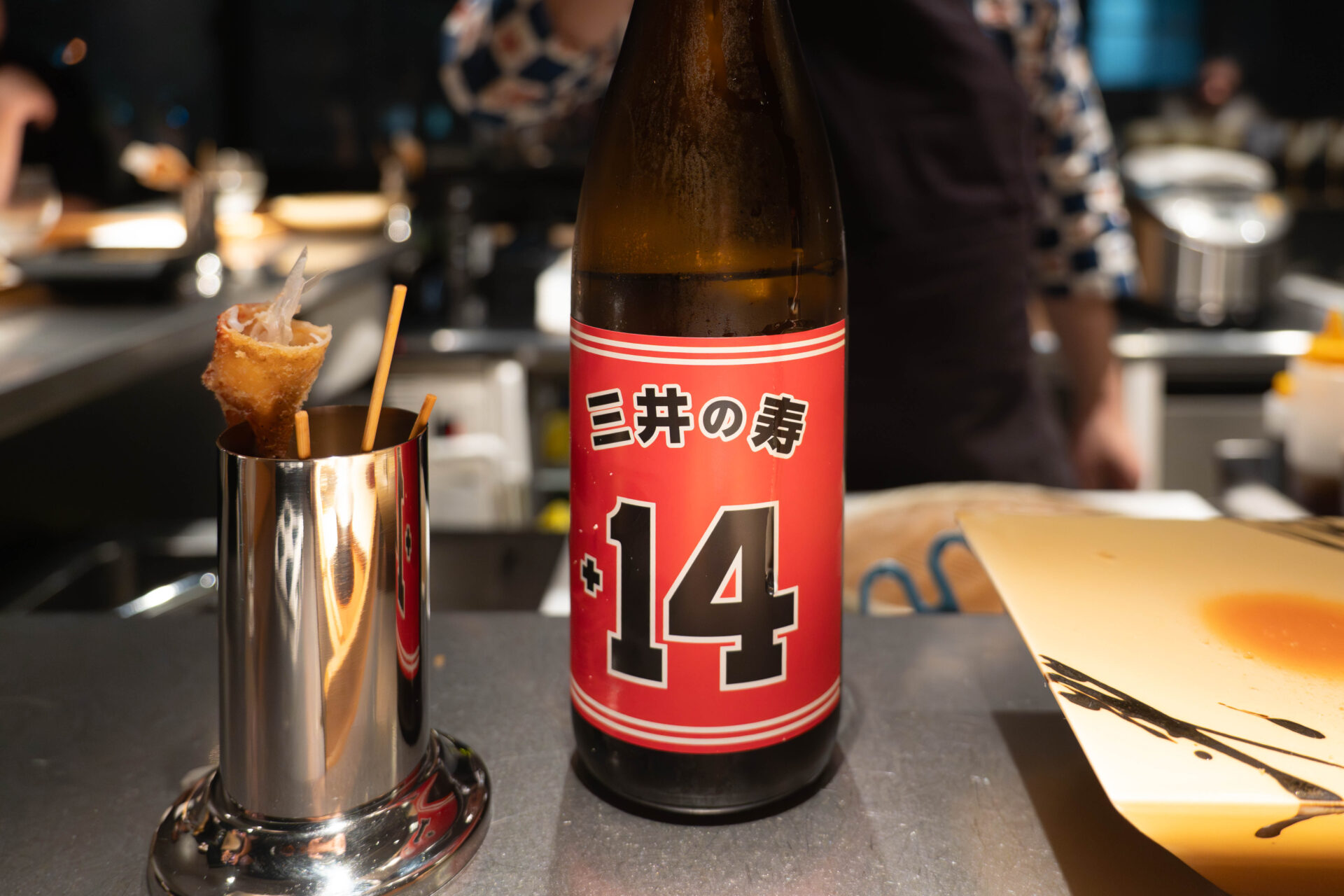
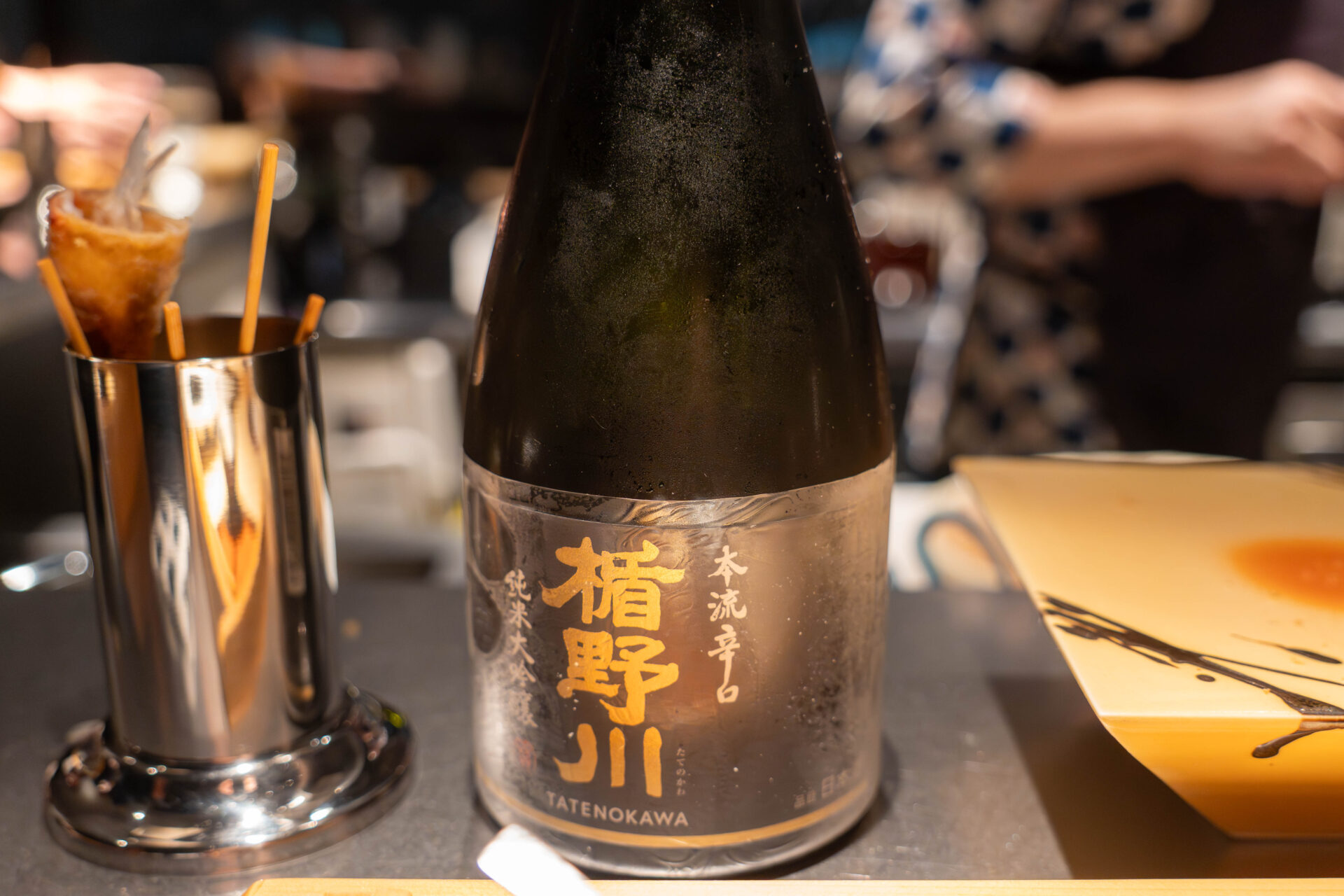
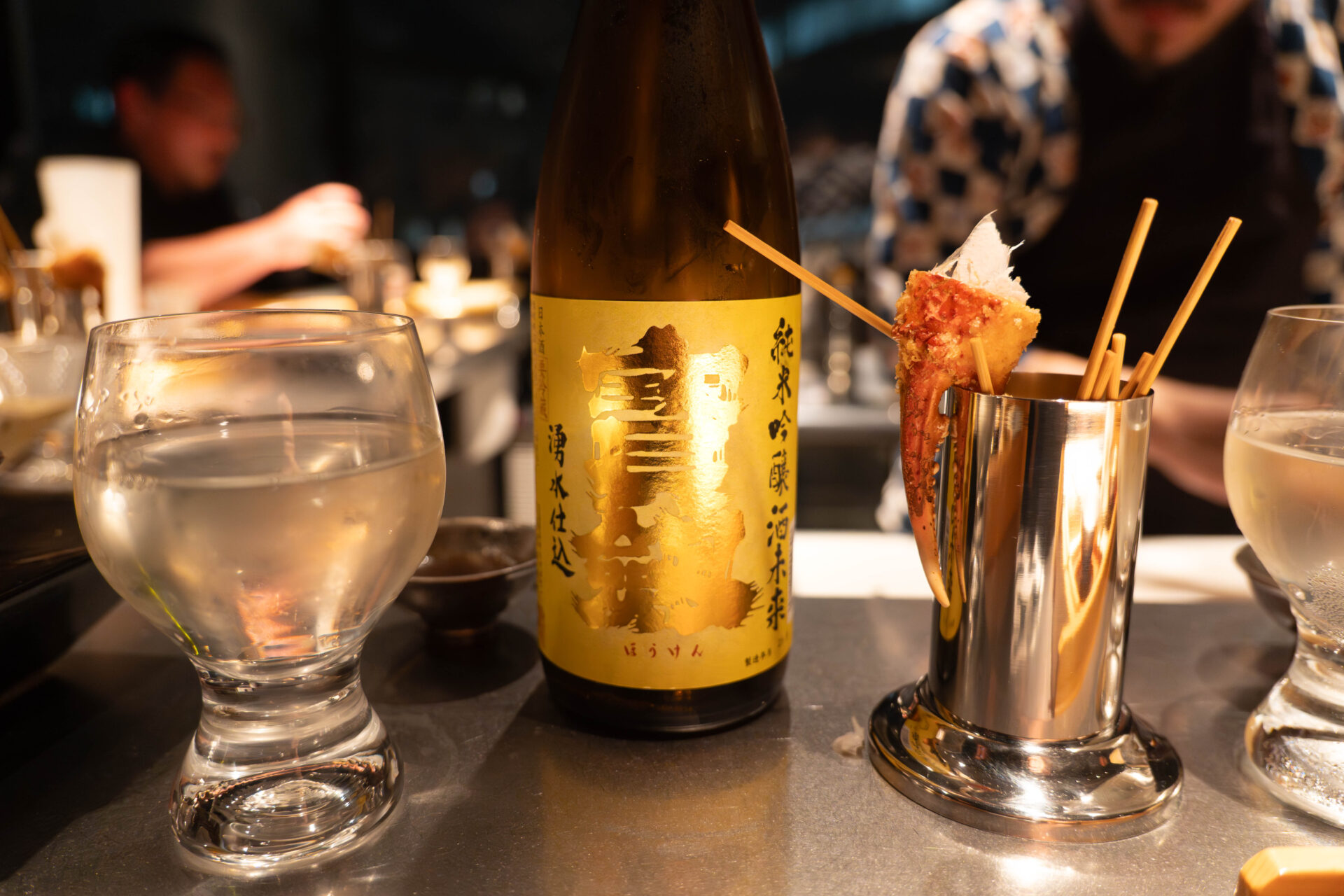
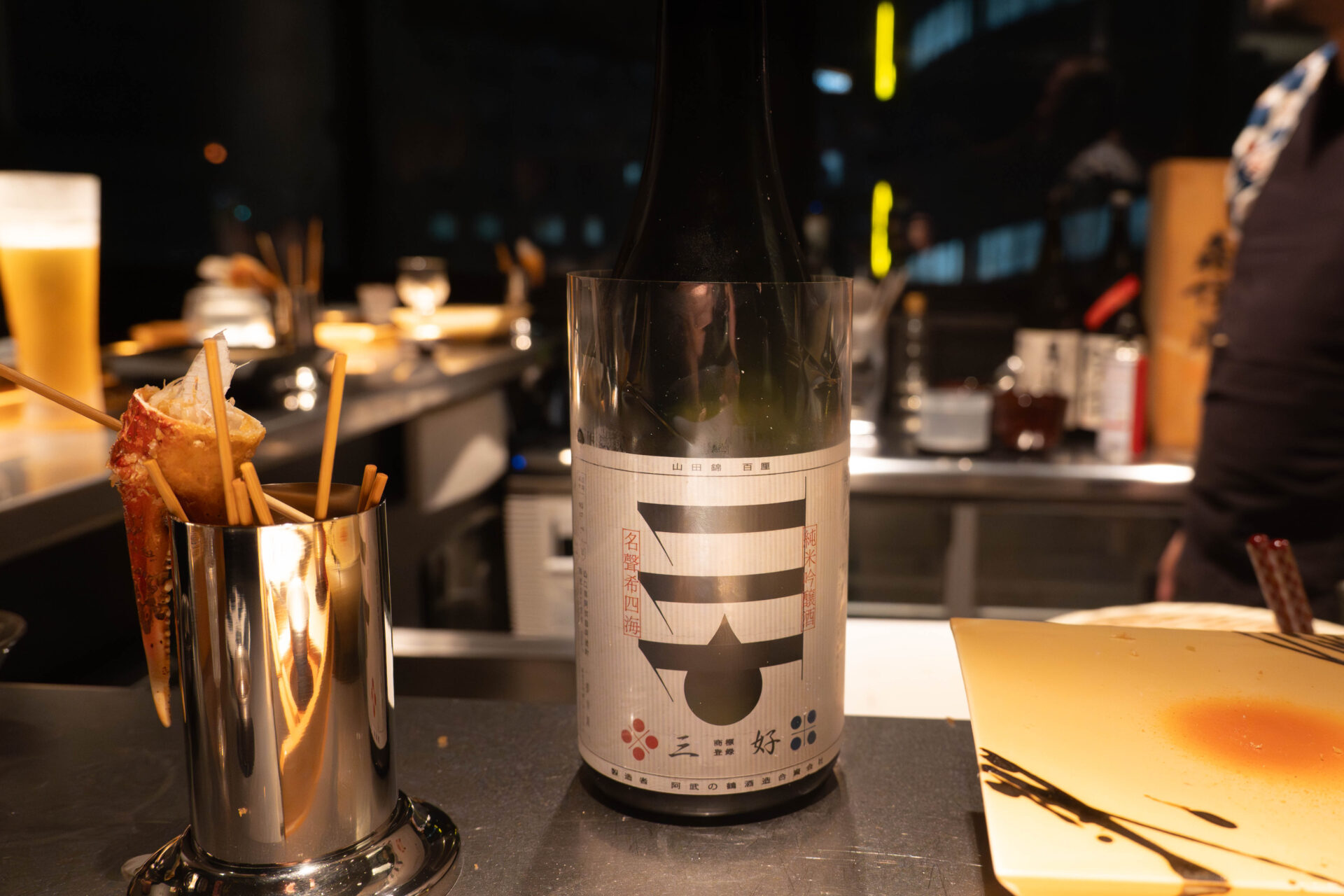
Reflections
“Kushiage Hayashi” has made a miraculous return to Nakasu, Fukuoka. One of the most memorable sights was Chef Hayashi listening to the sound of the oil — determining doneness by ear. Each skewer is timed with precision, considering even the residual heat, resulting in flawless execution.
Equally unforgettable is the chef himself — cheerful, approachable, and full of life. His warmth fills the counter, turning a meal into a shared, joyful memory rather than a mere dining experience.
The night doesn’t always end there — it often continues into second and third rounds with the chef himself. The connection that begins with food naturally extends into friendship, making every visit to Kushiage Hayashi feel personal and special.
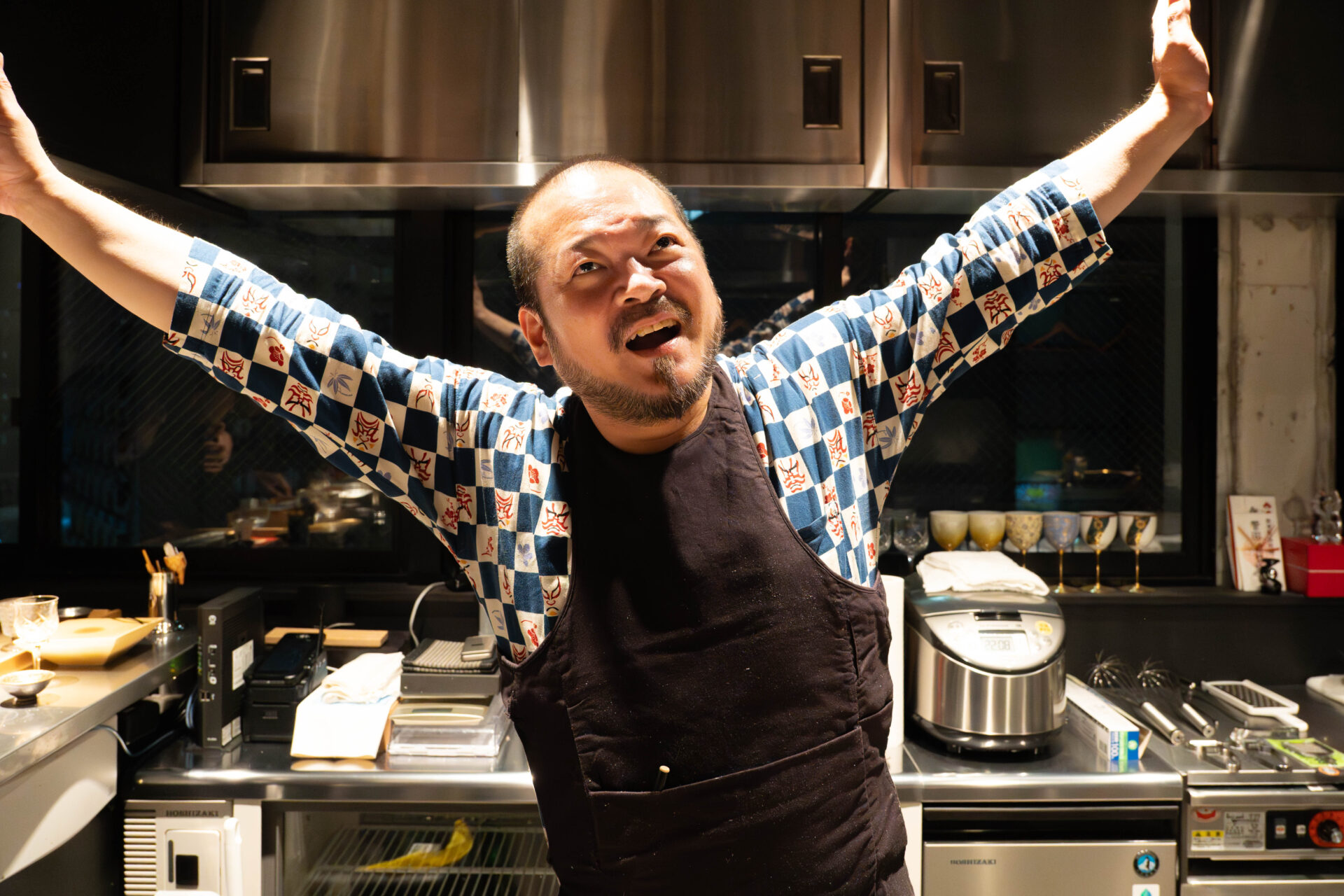
Reservations & Access
How to Reserve
- Reservations are required and accepted by phone only.
Tip:
Call about one month in advance of your preferred date, ideally between 1:00 p.m. and 5:00 p.m. Tables fill up quickly, so be prepared with multiple date options and try again if the line is busy.
Access Information
- Address: 702, modern bureau sumiyoshi riva, 1-6-8 Sumiyoshi, Hakata-ku, Fukuoka City, Fukuoka Prefecture
- Nearest stations:
– 3-minute walk from Kushida Jinja-mae Station (Nanakuma Subway Line)
– From Hakata Station: take the Airport Line, transfer to the Nanakuma Line, and get off at Kushida Jinja-mae
– From Tenjin: accessible via Tenjin-Minami on the Nanakuma Line - Note: No parking on site, but coin-operated parking is available nearby.
Hours & Regular Holiday
- Opening Hours: From 7:00 p.m.
- Closed: Irregular holidays
- TAGS

